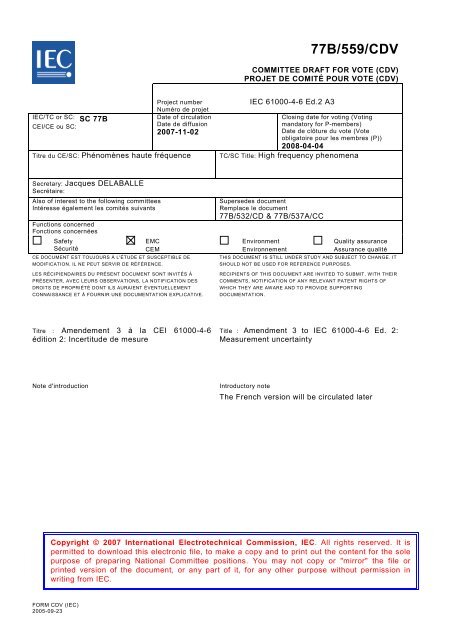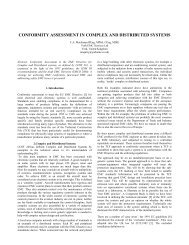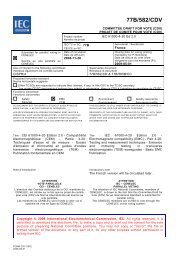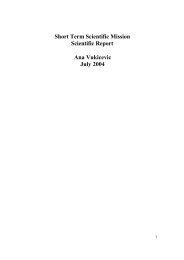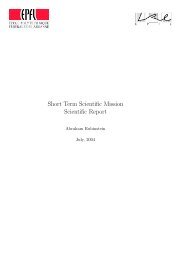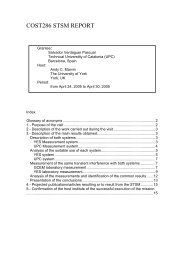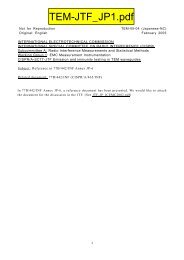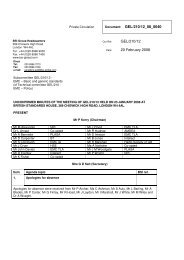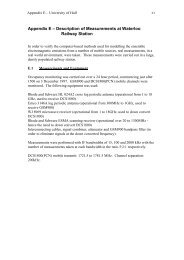07-38 - Applied Electromagnetics Group
07-38 - Applied Electromagnetics Group
07-38 - Applied Electromagnetics Group
You also want an ePaper? Increase the reach of your titles
YUMPU automatically turns print PDFs into web optimized ePapers that Google loves.
77B/559/CDV<br />
COMMITTEE DRAFT FOR VOTE (CDV)<br />
PROJET DE COMITÉ POUR VOTE (CDV)<br />
IEC/TC or SC: SC 77B<br />
CEI/CE ou SC:<br />
Project number<br />
Numéro de projet<br />
Date of circulation<br />
Date de diffusion<br />
20<strong>07</strong>-11-02<br />
Titre du CE/SC: Phénomènes haute fréquence<br />
IEC 61000-4-6 Ed.2 A3<br />
Closing date for voting (Voting<br />
mandatory for P-members)<br />
Date de clôture du vote (Vote<br />
obligatoire pour les membres (P))<br />
2008-04-04<br />
TC/SC Title: High frequency phenomena<br />
Secretary: Jacques DELABALLE<br />
Secrétaire:<br />
Also of interest to the following committees<br />
Intéresse également les comités suivants<br />
Functions concerned<br />
Fonctions concernées<br />
Safety<br />
Sécurité<br />
EMC<br />
CEM<br />
CE DOCUMENT EST TOUJOURS À L'ÉTUDE ET SUSCEPTIBLE DE<br />
MODIFICATION. IL NE PEUT SERVIR DE RÉFÉRENCE.<br />
LES RÉCIPIENDAIRES DU PRÉSENT DOCUMENT SONT INVITÉS À<br />
PRÉSENTER, AVEC LEURS OBSERVATIONS, LA NOTIFICATION DES<br />
DROITS DE PROPRIÉTÉ DONT ILS AURAIENT ÉVENTUELLEMENT<br />
CONNAISSANCE ET À FOURNIR UNE DOCUMENTATION EXPLICATIVE.<br />
Supersedes document<br />
Remplace le document<br />
77B/532/CD & 77B/537A/CC<br />
Environment<br />
Environnement<br />
Quality assurance<br />
Assurance qualité<br />
THIS DOCUMENT IS STILL UNDER STUDY AND SUBJECT TO CHANGE. IT<br />
SHOULD NOT BE USED FOR REFERENCE PURPOSES.<br />
RECIPIENTS OF THIS DOCUMENT ARE INVITED TO SUBMIT, WITH THEIR<br />
COMMENTS, NOTIFICATION OF ANY RELEVANT PATENT RIGHTS OF<br />
WHICH THEY ARE AWARE AND TO PROVIDE SUPPORTING<br />
DOCUMENTATION.<br />
Titre : Amendement 3 à la CEI 61000-4-6<br />
édition 2: Incertitude de mesure<br />
Title : Amendment 3 to IEC 61000-4-6 Ed. 2:<br />
Measurement uncertainty<br />
Note d'introduction<br />
Introductory note<br />
The French version will be circulated later<br />
Copyright © 20<strong>07</strong> International Electrotechnical Commission, IEC. All rights reserved. It is<br />
permitted to download this electronic file, to make a copy and to print out the content for the sole<br />
purpose of preparing National Committee positions. You may not copy or "mirror" the file or<br />
printed version of the document, or any part of it, for any other purpose without permission in<br />
writing from IEC.<br />
FORM CDV (IEC)<br />
2005-09-23
61000-4-6A3 Ed.2/CDV © IEC:200X – 2 –<br />
FOREWORD<br />
This amendment has been prepared by subcommittee 77B: High frequency phenomena, of<br />
IEC technical committee 77: Electromagnetic compatibility.<br />
The text of this amendment is based on the following documents:<br />
FDIS<br />
77B/XX/FDIS<br />
Report on voting<br />
77B/XX/RVD<br />
Full information on the voting for the approval of this amendment can be found in the report<br />
on voting indicated in the above table.<br />
The committee has decided that the contents of this amendment and the base publication will<br />
remain unchanged until the maintenance result date 1) indicated on the IEC web site under<br />
"http://webstore.iec.ch" in the data related to the specific publication. At this date, the<br />
publication will be<br />
• reconfirmed,<br />
• withdrawn,<br />
• replaced by a revised edition, or<br />
• amended.<br />
_____________<br />
—————————<br />
1) The National Committees are requested to note that for this publication the maintenance result date is 2010.
61000-4-6A3 Ed.2/CDV © IEC:200X – 3 –<br />
Annex G<br />
(informative)<br />
Measurement Uncertainty of Test Instrumentation<br />
G.1 Introduction<br />
This annex gives information related to Measurement Uncertainty (MU) according to the<br />
particular needs of the test method contained in the main body of the standard. Further<br />
information can be found in [1].<br />
This document focuses on the uncertainties for level setting. Other parameters of the<br />
disturbance quantity may be of equal importance and should also be considered by the test<br />
laboratory. The methodology shown in this annex is considered to be applicable to all<br />
parameters of the disturbance quantity.<br />
G.2 Uncertainty budgets for test methods<br />
G.2.1<br />
Definition of the measurand<br />
The measurand is the open circuit voltage U 0 , derived from the measurement of the output of<br />
the coupling device into a well defined 150 Ω voltage divider.<br />
G.2.2<br />
MU contributors of the measurand<br />
The following influence diagrams (Figures G.1 to G.4) give examples of influences upon the<br />
test method. It should be understood that the diagrams are not exhaustive. The most<br />
important contributors from the influence diagrams have been selected for the uncertainty<br />
budget Tables G.1, G.3, G.4 and G.5. At least these contributors listed in the Tables G.1, G.3,<br />
G.4 and G.5 shall be used for the uncertainty budgets in order to get comparable budgets for<br />
different test sites or laboratories. It is noted that a laboratory may include additional<br />
contributors (e.g. Type A) in the calculation of the MU, based on its particular circumstances.<br />
Level meter<br />
Test generator<br />
level<br />
Test generator<br />
linearity<br />
Test generator<br />
level drift<br />
Mismatch<br />
level meter/CDN<br />
Set-up for level<br />
setting<br />
Uncertainty in<br />
level setting<br />
SW levelling<br />
precision<br />
Power amp<br />
harmonics<br />
Power amp<br />
Compression<br />
CDN cal data<br />
Mismatch<br />
Test generator /<br />
CDN<br />
150 Ω to 50 Ω adapter<br />
Figure G.1: Example of influences upon the test method using CDN
61000-4-6A3 Ed.2/CDV © IEC:200X – 4 –<br />
Level meter<br />
Test<br />
generator level<br />
Test generator<br />
linearity<br />
Test generator<br />
level drift<br />
Mismatch<br />
level meter/clamp<br />
150 Ω to 50 Ω adapter<br />
Uncertainty in<br />
level setting<br />
SW levelling<br />
precision<br />
Power amp<br />
harmonics<br />
Power amp<br />
compression<br />
Monitoring system<br />
(current probe and<br />
meter)<br />
EM clamp<br />
calibration<br />
Mismatch Test generator /<br />
clamp<br />
Figure G.2: Example of influences upon the test method using EM clamp<br />
Level meter<br />
Test generator<br />
level<br />
Test generator<br />
linearity<br />
Test generator<br />
level drift<br />
150 Ω to 50 Ω<br />
adapter<br />
Mismatch<br />
Level meter /<br />
clamp<br />
Uncertainty in<br />
level setting<br />
Power amp<br />
compression<br />
SW levelling<br />
precision<br />
Power amp<br />
harmonics<br />
Monitoring system<br />
(current probe, meter)<br />
Clamp<br />
calibration<br />
Mismatch Test generator /<br />
clamp<br />
Figure G.3: Example of influences upon the test method using Current clamp<br />
Level meter<br />
Test<br />
generator level<br />
Test generator<br />
linearity<br />
Test generator<br />
level drift<br />
Mismatch<br />
Test generator /<br />
injection<br />
150 Ω to 50 Ω<br />
adapter<br />
Uncertainty in<br />
level setting<br />
SW levelling<br />
precision<br />
Power amp<br />
harmonics<br />
Power amp<br />
compression<br />
Direct injection<br />
calibration<br />
Decoupling<br />
devices<br />
Figure G.4: Example of influences upon the test method using direct injection
61000-4-6A3 Ed.2/CDV © IEC:200X – 5 –<br />
G.2.3<br />
Calculation examples for expanded uncertainty<br />
It must be recognized that the contributions which apply for calibration and for test may not be<br />
the same. This leads to (slightly) different uncertainty budgets for each process.<br />
The Tables G.1, G.3, G.4 and G.5 give examples of an uncertainty budget for level setting.<br />
Each uncertainty budget consists of 2 parts, the uncertainty for calibration and the uncertainty<br />
for test.<br />
Table G.1a: CDN calibration process<br />
Symbol Uncertainty Source u(x i ) Unit Distribution Divisor c i u i (y) Unit u i (y) 2<br />
RCAL 150 to 50 Ohm adapter, deviation 0.3 dB rect 1.73 1 0.17 dB 0.03<br />
150 to 50 Ohm adapter, calib. 0.2 dB normal k=2 2 1 0.10 dB 0.01<br />
SETUP Set-up for level setting 0.35 dB normal k=1 1 1 0.35 dB 0.12<br />
CDN CDN impedance 0.6 dB rect 1.73 1 0.35 dB 0.12<br />
LMc Level meter 0.5 dB rect 1.73 1 0.29 dB 0.08<br />
SWc SW levelling precision 0.3 dB rect 1.73 1 0.17 dB 0.03<br />
LMCc (a,b) Level meter in control loop 0 dB rect 1.73 1 0.00 dB 0.00<br />
TGc (a,b) Test generator 0 dB rect 1.73 1 0.00 dB 0.00<br />
MTc (c) Mismatch Test generator/CDN 0 dB U-shaped 1.41 1 0.00 dB 0.00<br />
ML Mismatch Level meter/CDN -0.5 dB U-shaped 1.41 1 -0.35 dB 0.13<br />
Σ u i (y) 2 0.52<br />
Combined uncertainty u(y)= √ Σ u i (y) 2 0.72<br />
Expanded Uncertainty (CAL ) U=u(y).k , k = 2<br />
1.45 dB<br />
Table G.1b: CDN test process<br />
Symbol Uncertainty Source u(x i ) Unit Distribution Divisor c i u i (y) Unit u i (y) 2<br />
CAL Calibration 1.45 dB normal k=2 2 1 0.72 dB 0.52<br />
LMCt (a,b) Level meter in control loop 0.3 dB rect 1.73 1 0.17 dB 0.03<br />
TGt (a,b) Test generator 0 dB rect 1.73 1 0.00 dB 0.00<br />
MTt (c) Mismatch Test generator/CDN 0 dB U-shaped 1.41 1 0.00 dB 0.00<br />
SWt SW levelling precision 0.3 dB rect 1.73 1 0.17 dB 0.03<br />
Σ u i (y) 2 0.58<br />
Combined uncertainty u(y)= √ Σ u i (y) 2 0.76<br />
Expanded uncertainty U=u(y).k, k = 2<br />
1.53 dB<br />
Notes:<br />
(a) Either LMC or TG contributions enter into the table for calibration and/or test, depending on whether a control<br />
loop for the signal generator and amplifier output level is used or not. A more detailed analysis of the TG<br />
contribution may be needed in case of not using a control loop, see explanation of terms.<br />
(b) If the same equipment is used for calibration and testing then only the contributions of repeatability and<br />
linearity enter into the table for the test process. The contribution for the calibration can be neglected.<br />
(c) If the same circuit is used for calibration and testing then these contributions do not enter into the table.<br />
Explanation of terms:<br />
RCAL - is the uncertainty of the 150 Ω to 50 Ω adapter. This contribution can normally be<br />
obtained from the calibration report. Alternatively the insertion loss can be measured using a<br />
network analyzer (see Fig. 7c of the main document). The maximum deviation from the<br />
specified loss (9,5 dB) and its calibration uncertainty should be included in the table. 0,5 dB<br />
should be used if the calibration certificate states only the compliance to the tolerance.<br />
Note 1: Deviations may be corrected in the software. In this case the maximum deviation can be reduced to the<br />
interpolation uncertainty and calibration uncertainty.<br />
Note 2: The impedance of the 150 Ω to 50 Ω adapter can also be measured directly, e.g. using a network analyzer<br />
or taken from the calibration certificate. In this case the deviation (in dB) from 100 Ω and the calibration uncertainty<br />
should be inserted in the table.
61000-4-6A3 Ed.2/CDV © IEC:200X – 6 –<br />
SETUP – is a combination of uncertainties introduced by the setup for level setting, i.e. cal<br />
fixture, the connection between the CDN and the CDN adapter and the ground plane impacts,<br />
e.g. contact to the ground plane. This contribution can be derived from reproducibility tests<br />
with changing conditions or estimated based on experience as done in the example.<br />
CDN – is the influence of the CDN impedance on the test level. This contribution does not<br />
cover a possible variation of the EUT impedance itself, only the contribution of the test<br />
instrumentation.<br />
Deviations of the CDN impedance result in an increased or decreased loop impedance of<br />
nominal 300 Ω. Thus a different signal level is established during the calibration process. If<br />
the EUT is 150 Ω the influence of the CDN impedance cannot be seen in the voltage at the<br />
EUT terminals. If the EUT impedance is high (open circuit as worst case) the EUT will be<br />
tested with a maximum voltage of U’ 0 . Table G.1a contains typical values for this contribution.<br />
The CDN impedance should be determined by measurements. The worst case situations are<br />
shown in Table G.2.<br />
U<br />
0<br />
Zloop<br />
= ⋅U<br />
300 Ω<br />
′ (G.1)<br />
0<br />
U′<br />
⎛ U′<br />
= 20 ⋅lg<br />
0<br />
⎜<br />
⎝ U<br />
⎞ ⎛Z<br />
⎟ = 20 ⋅lg⎜<br />
⎠ ⎝<br />
⎞<br />
300 Ω<br />
⎟<br />
⎠<br />
δ<br />
loop<br />
0, dB<br />
(G.2)<br />
0<br />
Table G.2: Uncertainty in dependence of CDN impedance variations<br />
Impedance of<br />
the CDN<br />
Ω<br />
Loop<br />
impedance<br />
Z loop<br />
Ω<br />
δU 0,dB<br />
dB<br />
150 300 0,0<br />
170 320 0,6<br />
130 280 -0,6<br />
210 360 1,6<br />
105 255 -1,4<br />
LM c – is the uncertainty of the level meter, i.e. voltmeter or power meter used for<br />
measurement of the level at the output of the CDN. It is taken from the manufacturer’s<br />
specifications in the example but could be determined from other sources as well.<br />
SW c – is the uncertainty derived from the discrete level step size of the signal generator and<br />
software windows for level setting during the calibration process. The software window can<br />
usually be adjusted by the test lab.<br />
LMC c – is the uncertainty of the level meter, i.e. voltmeter or power meter used for control<br />
loop for the signal generator and amplifier output level. It can be taken from the<br />
manufacturer’s specifications or determined from other sources.<br />
TG c – is the uncertainty of the test generator including frequency generator, power amplifier<br />
and attenuator. It can be taken from the manufacturer’s specifications or determined from<br />
other sources.
61000-4-6A3 Ed.2/CDV © IEC:200X – 7 –<br />
Note: The uncertainty of the individual components of the test generator (e.g. signal generator, power amplifier<br />
stability, power amplifier rapid gain variation, attenuator etc.) may have to be assessed separately, especially in<br />
case of not using a control loop in the test setup.<br />
MT c – is a combination of the mismatches between amplifier, attenuator and CDN.<br />
ML – is the mismatch between the CDN and the level meter.<br />
CAL – is the expanded uncertainty of the test voltage level.<br />
LMC t – is the uncertainty of the level meter, e.g. voltmeter, used at the output of the power<br />
amplifier taken from manufacturer specification. Alternatively a power meter can be used in<br />
order to obtain a lower uncertainty.<br />
TG t – is the uncertainty of the test generator including frequency generator, power amplifier<br />
and attenuator. It can be taken from the manufacturer’s specifications or determined from<br />
other sources.<br />
Note: The uncertainty of the individual components of the test generator (e.g. signal generator, power amplifier<br />
stability, power amplifier rapid gain variation, attenuator etc.) may have to be assessed separately, especially in<br />
case of not using a control loop in the test set-up.<br />
MT t – is a combination of the mismatches between amplifier, attenuator and CDN. This<br />
contribution can be neglected if the same setup, i.e. attenuator and cables, is used for<br />
calibration and test.<br />
SW t – is the uncertainty derived from the discrete level step size of the signal generator and<br />
software windows for level setting during the test process. The software window can usually<br />
be adjusted by the test lab.
61000-4-6A3 Ed.2/CDV © IEC:200X – 8 –<br />
Table G.3a: EM clamp calibration process<br />
Symbol Uncertainty Source u(x i ) Unit Distribution Divisor c i u i (y) Unit u i (y) 2<br />
RCAL 150 to 50 Ohm adapter, deviation 0.3 dB rect 1.73 1 0.17 dB 0.03<br />
150 to 50 Ohm adapter, calib. 0.2 dB normal k=2 2 1 0.10 dB 0.01<br />
SETUP Set-up for level setting 0.35 dB normal k=1 1 1 0.35 dB 0.12<br />
EM EM clamp 1 dB normal k=2 2 1 0.50 dB 0.25<br />
LMc Level meter 0.5 dB rect 1.73 1 0.29 dB 0.08<br />
SWc SW levelling precision 0.3 dB rect 1.73 1 0.17 dB 0.03<br />
LMCc (a,b) Level meter in control loop 0 dB rect 1.73 1 0.00 dB 0.00<br />
TGc (a,b) Test generator 0 dB rect 1.73 1 0.00 dB 0.00<br />
MTc (c) Mismatch Test generator/clamp 0 dB U-shaped 1.41 1 0.00 dB 0.00<br />
ML Mismatch Level meter/clamp -0.5 dB U-shaped 1.41 1 -0.35 dB 0.13<br />
Σ u i (y) 2 0.65<br />
Combined uncertainty u(y)= √ Σ u i (y) 2 0.81<br />
Expanded Uncertainty (CAL ) U=u(y).k , k = 2<br />
1.61 dB<br />
Table G.3b: EM clamp test process<br />
Symbol Uncertainty Source u(x i ) Unit Distribution Divisor c i u i (y) Unit u i (y) 2<br />
CAL Calibration 1.61 dB normal k=2 2 1 0.81 dB 0.65<br />
LMCt (a,b) Level meter in control loop 0.3 dB rect 1.73 1 0.17 dB 0.03<br />
TGt (a,b) Test generator 0 dB rect 1.73 1 0.00 dB 0.00<br />
MTt (c) Mismatch Test generator/clamp 0 dB U-shaped 1.41 1 0.00 dB 0.00<br />
SWt SW levelling precision 0.3 dB rect 1.73 1 0.17 dB 0.03<br />
AETERM AE termination 2.5 dB rect 1.73 1 1.45 dB 2.09<br />
Σ u i (y) 2 2.80<br />
Notes:<br />
Combined uncertainty u(y)= √ Σ u i (y) 2 1.67<br />
Expanded uncertainty U=u(y).k, k = 2<br />
3.35 dB<br />
(a) Either LMC or TG contributions enter into the table for calibration and/or test, depending on whether a control<br />
loop for the signal generator and amplifier output level is used or not. A more detailed analysis of the TG<br />
contribution may be needed in case of not using a control loop, see explanation of terms.<br />
(b) If the same equipment is used for calibration and testing then only the contributions of repeatability and<br />
linearity enter into the table for the test process. The contribution for the calibration can be neglected.<br />
(c) If the same circuit is used for calibration and testing then these contributions do not enter into the table.<br />
Explanation of terms:<br />
Several items apply in principle as for the previous example (CDN method). These items are<br />
not explained here, please refer to the previous example.<br />
Note Uncertainty related to Clause 7.4 where monitoring probe is used and current limitation is applied is not<br />
considered in this annex. In this case the value of U 0 is no longer the same that was determined in the level setting<br />
procedure, but it is reduced to an unknown value. Therefore no uncertainty can be assigned to U 0 in this case.<br />
EM – is the uncertainty of the EM clamp characterization, mostly due to the deviation of the<br />
output impedance from 150 Ω.<br />
AETERM – is the effect of the AE impedance, which should be maintained at 150 Ω.<br />
Deviations have significant influence especially in the lower frequency range (below 10 MHz),<br />
where the directivity of the EM clamp is weak. This is assumed for the value given in the<br />
table. A lower value may be used for frequencies above 10 MHz.<br />
This contribution can be investigated experimentally using a network analyzer. The coupling<br />
factor of the clamp can be measured for a 150 Ω AE impedance and compared to different AE<br />
impedances.
61000-4-6A3 Ed.2/CDV © IEC:200X – 9 –<br />
Table G.4a: Current clamp calibration process<br />
Symbol Uncertainty Source u(x i ) Unit Distribution Divisor c i u i (y) Unit u i (y) 2<br />
RCAL 150 to 50 Ohm adapter, deviation 0.3 dB rect 1.73 1 0.17 dB 0.03<br />
150 to 50 Ohm adapter, calib. 0.2 dB normal k=2 2 1 0.10 dB 0.01<br />
JIG Calibration jig 0.5 dB normal k=1 1 1 0.50 dB 0.25<br />
LMc Level meter 0.5 dB rect 1.73 1 0.29 dB 0.08<br />
SWc SW levelling precision 0.3 dB rect 1.73 1 0.17 dB 0.03<br />
LMCc (a,b) Level meter in control loop 0 dB rect 1.73 1 0.00 dB 0.00<br />
TGc (a,b) Test generator 0 dB rect 1.73 1 0.00 dB 0.00<br />
MTc (c) Mismatch Test generator/clamp 0 dB U-shaped 1.41 1 0.00 dB 0.00<br />
ML Mismatch Level meter/clamp -0.5 dB U-shaped 1.41 1 -0.35 dB 0.13<br />
Σ u i (y) 2 0.53<br />
Combined uncertainty u(y)= √ Σ u i (y) 2 0.73<br />
Expanded Uncertainty (CAL ) U=u(y).k , k = 2<br />
1.46 dB<br />
Table G.4b: Current clamp test process<br />
Symbol Uncertainty Source u(x i ) Unit Distribution Divisor c i u i (y) Unit u i (y) 2<br />
CAL Calibration 1.46 dB normal k=2 2 1 0.73 dB 0.53<br />
LMCt (a,b) Level meter in control loop 0.3 dB rect 1.73 1 0.17 dB 0.03<br />
TGt (a,b) Test generator 0 dB rect 1.73 1 0.00 dB 0.00<br />
MTt (c) Mismatch Test generator/clamp 0 dB U-shaped 1.41 1 0.00 dB 0.00<br />
SWt SW levelling precision 0.3 dB rect 1.73 1 0.17 dB 0.03<br />
AETERM AE termination 2.5 dB rect 1.73 1 1.45 dB 2.09<br />
Σ u i (y) 2 2.68<br />
Combined uncertainty u(y)= √ Σ u i (y) 2 1.64<br />
Expanded uncertainty U=u(y).k, k = 2<br />
3.27 dB<br />
Notes:<br />
(a) Either LMC or TG contributions enter into the table for calibration and/or test, depending on whether a control<br />
loop for the signal generator and amplifier output level is used or not. A more detailed analysis of the TG<br />
contribution may be needed in case of not using a control loop, see explanation of terms.<br />
(b) If the same equipment is used for calibration and testing then only the contributions of repeatability and<br />
linearity enter into the table for the test process. The contribution for the calibration can be neglected.<br />
(c) If the same circuit is used for calibration and testing then these contributions do not enter into the table.<br />
Explanation of terms:<br />
Several items apply in principle as for one of the previous examples (e.g. CDN method).<br />
These items are not explained here, please refer to one of the previous examples.<br />
Note Uncertainty related to Clause 7.4 where monitoring probe is used and current limitation is applied is not<br />
considered in this annex. In this case the value of U 0 is no longer the same that was determined in the level setting<br />
procedure, but it is reduced to an unknown value. Therefore no uncertainty can be assigned to U 0 in this case.<br />
JIG – is a combination of uncertainties introduced by the test jig. This contribution can be<br />
derived from reproducibility tests with changing conditions or estimated based on experience<br />
as done in the example.
61000-4-6A3 Ed.2/CDV © IEC:200X – 10 –<br />
Table G.5a: Direct injection calibration process<br />
Symbol Uncertainty Source u(x i ) Unit Distribution Divisor c i u i (y) Unit u i (y) 2<br />
RCAL 150 to 50 Ohm adapter, deviation 0.3 dB rect 1.73 1 0.17 dB 0.03<br />
150 to 50 Ohm adapter, calib. 0.2 dB normal k=2 2 1 0.10 dB 0.01<br />
SETUP Set-up for level setting 0.5 dB normal k=1 1 1 0.50 dB 0.25<br />
LMc Level meter 0.5 dB rect 1.73 1 0.29 dB 0.08<br />
SWc SW levelling precision 0.3 dB rect 1.73 1 0.17 dB 0.03<br />
LMCc (a,b) Level meter in control loop 0 dB rect 1.73 1 0.00 dB 0.00<br />
TGc (a,b) Test generator 0 dB rect 1.73 1 0.00 dB 0.00<br />
MTc (c) Mismatch Test generator/CDN 0 dB U-shaped 1.41 1 0.00 dB 0.00<br />
ML Mismatch Level meter/CDN -0.5 dB U-shaped 1.41 1 -0.35 dB 0.13<br />
Σ u i (y) 2 0.53<br />
Combined uncertainty u(y)= √ Σ u i (y) 2 0.73<br />
Expanded Uncertainty (CAL ) U=u(y).k , k = 2<br />
1.46 dB<br />
Table G.5b: Direct injection test process<br />
Symbol Uncertainty Source u(x i ) Unit Distribution Divisor c i u i (y) Unit u i (y) 2<br />
CAL Calibration 1.46 dB normal k=2 2 1 0.73 dB 0.53<br />
LMCt (a,b) Level meter in control loop 0.3 dB rect 1.73 1 0.17 dB 0.03<br />
TGt (a,b) Test generator 0 dB rect 1.73 1 0.00 dB 0.00<br />
MTt (c) Mismatch Test generator/clamp 0 dB U-shaped 1.41 1 0.00 dB 0.00<br />
SWt SW levelling precision 0.3 dB rect 1.73 1 0.17 dB 0.03<br />
DD Decoupling devices 2.3 dB rect 1.73 1 1.33 dB 1.77<br />
Σ u i (y) 2 2.36<br />
Notes:<br />
Combined uncertainty u(y)= √ Σ u i (y) 2 1.54<br />
Expanded uncertainty U=u(y).k, k = 2<br />
3.<strong>07</strong> dB<br />
(a) Either LMC or TG contributions enter into the table for calibration and/or test, depending on whether a control<br />
loop for the signal generator and amplifier output level is used or not. A more detailed analysis of the TG<br />
contribution may be needed in case of not using a control loop, see explanation of terms.<br />
(b) If the same equipment is used for calibration and testing then only the contributions of repeatability and<br />
linearity enter into the table for the test process. The contribution for the calibration can be neglected.<br />
(c) If the same circuit is used for calibration and testing then these contributions do not enter into the table.<br />
Explanation of terms:<br />
Several items apply in principle as for one of the previous examples (e.g. CDN method).<br />
These items are not explained here, please refer to one of the previous examples.<br />
DD – is a combined uncertainty of the decoupling devices and the AE termination. Good<br />
decoupling gives less effect of the AE termination, poor decoupling gives a strong effect. This<br />
contribution can be calculated from the impedance of the decoupling element.<br />
G.3 Application<br />
The calculated MU number (expanded uncertainty) should be used as a method of evaluating<br />
the quality of a lab’s test process. It is not intended that the result of this calculation be used<br />
for adjusting the test level that is applied to EUTs during the test process.<br />
G.4 Bibliography<br />
[1] 77/349/INF, General information on measurement uncertainty of test<br />
instrumentation for conducted and radiated RF immunity tests


